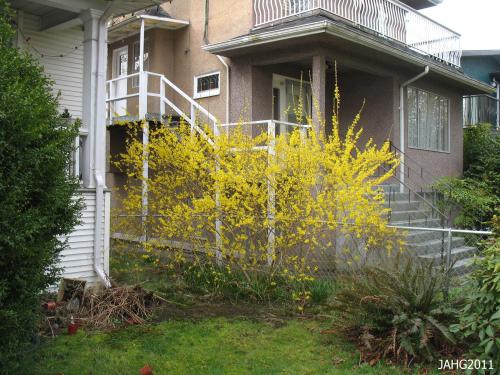When I first started horticulture school many years ago it was autumn and the leaves where changing color. The trees and shrubs we were leaning were all new to me and often did not impress me too much in ragged end of year state. As the season progressed into winter I learned to appreciate the form and shape of the simple things like tree structure, bark and buds and the often subtle differences between closely related species. The spring brought new hope of reawakening in the city which was my new classroom, those buds expanded and soon the earliest flowers were blooming. All around was color, especially yellow and the most vibrant of all were the Golden Bells or Common Forsythia (Forsythia x intermedia).
Forsythias like so many plants comes from the vast area of eastern Asia. There are 11 known species with only 1 which originates from Europe.The most important species in horticulture are Forsythia suspensa, viridissima, ovata and japonica. From this group the suspensa x viridissima which is known as F. x intermedia is the most important and has contributed a number of well known garden plants.

Although the flowers of Forsythia x intermedia are small, there are thoousands which coat the branches.
Forsythia x intermedia is a cross of 2 species(suspensa x viridissima) which originate in China. The first species seen and written about was F. suspensa (Weeping Forsythia) which was seen by Carl Peter Thunberg in Japan where he was posted in 1784. At that time he thought it was a form of Lilac (Syringa) and called it Syringa suspensa. An interesting factoid is that Lilacs and Forsythia are in the same family as Olives (Oleaceae). This species brings a drooping habit to its branches and has rambling/suckering growth.

The 'greenstem' influence of Forsythia viridissima is seen here along with the slightly angular surface. The lenticels (bumps on bark) are typical for the species.
The other species in the cross is viridissima which is also from China and was discovered by Robert Fortune in about 1850. Greenstem Forsythia blooms later than any of the other Forsythia species and has noticeably green, square stems. It is thought the species met in Holland and naturally crossed there but it also just as likely that there are natural crosses found in the wild where the plant species grow in the same areas close together.

The hardy Forsythia x intermedia buds are set in the fall and over-winter tightly before they burst forth into bloom usually in late February around here.
Forsythia x intermedia are considered to be somewhat out of fashion these days because they are not really a controlled plant. I found it interesting that when I moved here to Victoria that it is hard to find these plants as they are much more common in the Vancouver area where I had been living at. Victoria is an older city than Vancouver and Forsythia are a very ‘Victorian era’ type of plant and I just assumed in the spring they would show up in the older yards around here.
Forsythia x intermedia are easy to grow and will live for many decades in the right place. They take all most any soil as long as it drains well and is not totally clay. They produce the best flowering in full sun but take light shade and give a good flower display. They often grow into dense multi-stemmed shrubs which sucker to expand that gives them a messy appearance. They typically grow up to 3.5 m. (10 ft.) by a similar width. The branches can be seen growing upright or drooping on the same plant. Branches that touch the soil and remain there often will root and produce new growth. These plants can be severely pruned into shrubs but most of the flowers will be lost, often only seen deep in the plant or on the top. Free form, informal hedges (less clipped) are beautiful and bright if you have the space.

Here Forsythia x intermedia is seen with another brightly flowering shrub Pieris 'Valley Valentine'.
Often Forsythia x intermedia is not noticed until it bursts into color in the spring just when we need the bright colors to help us wake up from our winter slumber. It an excellent shrub for early spring color and autumn color as it often shows tinges of madder and plum in its golden foliage. Use Forsythia in mixed borders for early spring color, winter gardens, low maintainance areas, as informal or formal hedges or in heritage gardens. Another favorite use is for forcing the flowers by bringing in branches and letting them open inside. The best thing might be that it is quite hardy and tolerates -20 c. (-4 f.) and I have seen it growing in much colder places than that with sheltering from harsh north winds. As a side note if you live in a very cold climate look out for Forsythia ‘Northern Gold’ which takes zone 3 (-40 c. or f.).
Following Forsythia:
What People are saying about their plants: http://davesgarden.com/guides/pf/go/74859/
One of the best places to look up shrubs and tree and their description: http://www.hort.uconn.edu/plants/f/forint/forint1.html
The Genus Forsythia: http://en.wikipedia.org/wiki/Forsythia
For you gardeners in the north here is Forsythia ‘North Gold’ http://www.northscaping.com/InfoZone/FS-0038/FS-0038.shtml
…….Hope you follow along with me here……


 Stumble It!
Stumble It!






